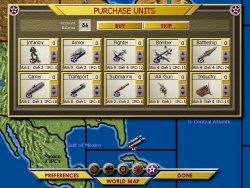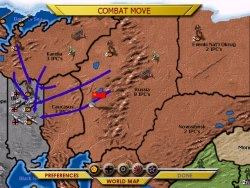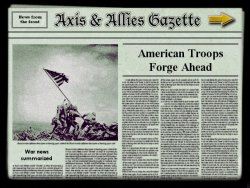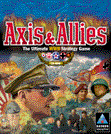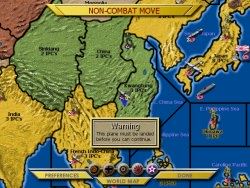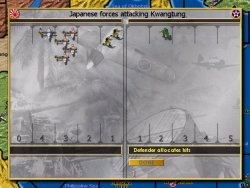| AXIS
AND ALLIES REVIEW by ... Maurice Fitzgerald |
||||
| Twenty years after the concept was first being worked out as a board game, Axis
and Allies now finds itself a new medium, the PC. Hasbro Interactive has
recently released the PC port of the highly popular board game and has
gotten off to a rather shaky start.
Plagued with bugs, A&A has been met with mixed reactions amongst gamers. While hard corps A&A players have found the game AI not the most challenging, newer players have found themselves frustrated with multiplayer matches. Much to HIís credit there have already been two patches released to fix a number of issues, and gameplay has become more stable. The latest patch will bring your copy up to version 1.2 and is required for gameplay on the MSN Gaming Zone. I can remember playing the board game about 10 years ago for the first time. It was a very engrossing game and one that easily found me devoting several hours at a time. In the ensuing 10 years I havenít been able to play much, since few people I know are into board games. Fortunately the past year or two has been good for board game fans, as weíve seen several of our all-time favorites brought to the PC.
No longer are we forced to trek long miles to another gamers home to set up the playing pieces, get a few hours of good gaming in and then tear down shop and leave town. While some gamers donít have a problem finding a good gaming group, others are less likely to enjoy that travelling circus lifestyle just to play a board game. Luckily for us games like Monopoly, Battleship and now Axis and Allies have been made available for play on the PC. With multiplayer support included itís much easier to find a good game and itís as easy as hopping online, logging into your favorite gaming service and joining a match. From Cardboard to Virtual Reality The PC version is identical to the board game version minus the pieces to set up (or clean up!) and the computer does all the dice rolls for you. Set in 1942 as the world is at war, you must choose from any of the five major powers of WWII to command, both militarily as well as economically. While the economics are kept rather simple, the decisions you make are not always easy. As leader you must decide what to buy, how much to buy and when if at all to attempt investing in new weapons development. New weapon development costs money and will fail you more often than not, but it could also help you turn the tide of the war, so the choice is yours as supreme commander. You are not limited to just choosing one country, but can play as the entire Axis or Allied side. The Axis consists of Germany and Japan, and the Allies consist of the US, UK and Russia. I found it easiest to start by just taking command of one country, until youíve become familiar with the game mechanics and basic strategies. From there you can control the entire Axis or Allied side and fight the war from that point forward. The game map is an exact replica of the board game map: the entire globe is broken into different territories and under the control of the power that held it at that time in history. Each country has its own distinct color and the territories are shaded in the color of the country who retains control, making for easy clarification. As your countries are won and lost the colors change to reflect those wins and losses and give you an instant status as to how you are doing. The game pieces are also very similar to their board game counterparts and are easily recognizable as well.
You have a choice of two zoom modes: close in for your basic movement and fighting, or an entire global view from which you can see an overall snapshot of the world at large. The only problem I saw with this was in multiplayer games as while youíre sitting back awaiting your turn your map view is basically controlled by the player whose turn it is. As he moves his pieces your map view scrolls to follow him, making it a bit of a distraction while trying to study the map yourself to plan your future moves. It would have been nice to have a separate window that you could open to see the entire map screen and not be bothered by another players moves. |
This would have served two purposes: to allow you to study and plan for your moves, as well as to speedup gameplay by each gamer not needing to take extra time during his turn to observe the map and plan movement. Perhaps this could be fixed in a future revision, itís annoying but not a game killer. There is too much substance here for this issue to kill gameplay. Also bear in mind this is a PC version of a board game, so there are concessions that have to be made. Gameplay is very true to the board game and follows the same rules as well as allowing a new 3rd Edition rules specifically for the PC. These new rules include submerging submarines which allows a sub to submerge and evade from combat instead of retreating to a sea zone. Planes are able to retreat from an amphibious assault now, so that they donít get wasted away defending a battle that looks to be lost. You can now place multiple AA guns in a territory, but still only one of them may fire in a given turn. You can also tweak and adjust the rules to your liking and follow any personal rule variants you might have enjoyed in the past as well as use the included edit unit feature which allows you to change unit attributes to your liking. This game does give fans of A&A some freedom and latitude in creating a gaming environment of their own design, allowing you to throw in your own take on Ďwhat ifí scenarios. Winning the game is done much along the historical lines of World War II. As the Allied powers you must attain the unconditional surrender of the Axis. The Axis powers can win by either of two means: simply taking control of two of your opponents capitals, or by winning enough territories to give you an economic victory. Both sides have their work cut out for them and in playing this game you will get a pretty good feel for the decisions each sides Commander must have faced. A&A is a turn based game and each players turn is done in order. Russia leads off, Germany next, followed by the UK, Japan and finally the US. All turns are broken down into phases of which there are 6. Your first phase is to choose to develop weapons and purchase units for later placement at the end of your turn. Weapons development is a risky venture, much as it is in the real world, and is done at the cost of IPCís or Industrial Production Certificates: a fancy and simple way of saying "money." Every war machine moves on money and will suffer or do well based on your cash flow. IPCís are alloted to each territory you have and will continue to be a source of income each turn that you have it in your control. Lose a territory and you lose cash which will hinder your military production. Likewise as you gain the territories of your foes you take away money from their pockets and into your own, increasing your military production. To pursue weapons development you must buy dice at a cost of 5 IPCís each, a roll of 6 will give you a military breakthrough. If you roll any other number you have been unsuccessful, if you have IPCís left over you may then purchase units if you choose. Each unit has its own cost, and based on what your plans are for future moves you make your purchases. The cheapest unit is infantry: a very good unit to buy when beefing up defense of your production capitals when faced with a coming attack. Other units available to you are tanks, fighters, bombers, battleships, troop transports, submarines, aircraft carriers, AA guns and extra production facilities. Units you purchase do not get placed on the board until the end of your turn and must be placed in a territory that has a production facility for land units or in a sea zone adjacent to a production facility for ships. The second and third phases are combat movement and actual combat itself. Combat movement is done based on movement capabilities of your units and is represented on the map through arrows, similar to those weíve all seen in WWII tactical maps. While playing this I was reminded of those old WWII movies of the field marshals in their command posts standing over huge table top maps as their aids pushed pieces around with their placement sticks. This game gives you that same grand tactical feel and itís done quite convincingly.
|
|||
|
© 1997 - 2000 COMBATSIM.COM, INC. All Rights Reserved. Last Updated November 15th, 1998 |
||||

